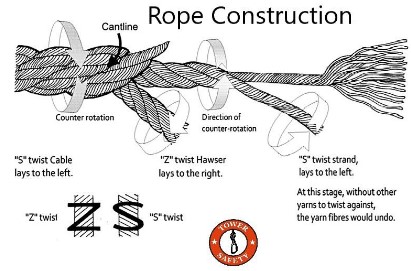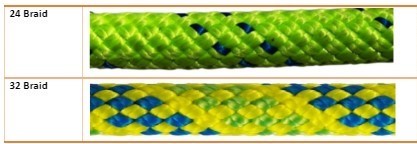Kathy Gill knows the ropes, literally. As the President of a tower safety training school, Tower Safety in Phoenix, AZ, it’s not only her job to know but it’s the lives of her students that are at stake if she doesn’t stay in a constant state of alert on the condition of their climbing gear. She said the condition of the ropes can often get overlooked on a safety checklist, which could be a fatal mistake. This is the first in an Inside Towers series about ropes with videos to follow on links here and on social media.
Ropes were used by the Egyptians using natural fibers and date back to almost 4000 B.C. and about 2800 B.C., the Chinese created rope made of hemp fibers which is commonly known as Manila Rope. Since then, technology has advanced fibers/raw materials into being stronger than steel. Rope material and construction has gotten so much better, ANSI states, that no rope used as a climb line can be made of natural material. Much goes into the choice of ropes depending on the use and elongation, impact absorption, handling, strength, and durability.
Most common fibers/raw materials for static ropes:
- Aramid – Technora/Twaron/Kevlar
- Polyster and Polyester with various fiber cores
- Nylon/Polyamide
- Polypropylene
- HMPA (High Modulus Polyethylene)
Rope Construction
Gill said all ropes often fall into the same category of testing, EN 1891 Type A and must conform to ANSI Z133 specifications for strength, diameter, and elongation.
Braid Pattern: A description of the way the strands of a braided rope are intertwined. A plain (diamond) pattern is when one strand (or multiple strand) of one direction of rotation about the axis passes over one strand in the opposite direction and it in turn passes under the next strand of the opposite direction. A twill pattern is when one strand (or multiple strand) of one direction of rotation about the axis passes over two strands of the opposite direction and it in turn passes under the next two strands of the opposite direction. Twisting creates the strands that make up the core and sheath and there are two directions of twist, “S” twist or counterclockwise and “Z” twist or clockwise to give the rope balance to not spin when loaded.
Ropes have a shelf life of 10 years, but a working life limited of five years, but always check with the manufacturer – ropes must be retired sooner if defects are noticed.” ropes need to be retired based on the number of jobs and if it fails inspection. A rope log with inspection notes is required, Gill said.
Type of rope categories are:
- 24-Braid: This construction gives a good balance between a thick durable cover whilst retaining space for core
- 32-Braid
- 48-Braid: A thinner cover than either 24-plait or 32 allowing bigger/stronger core
- Double-Braid: Used for Marine, hand/winch/pulling lines, not good for use in pulleys
- Polypropylene: Not good for lifting, floats, used for Marine
- Aramid: Stronger than steel
- Unicore Technology®: 32 strand. The sheath of a UNICORE rope stays connected to the core, even when the rope gets cut or wet; keeping both parts of the rope acting as one. UNICORE is stretchy, supple, and compatible with Beal’s special water and abrasion resistant treatments. This means that the UNICORE technology can be used on both dynamic and static ropes as well as ropes intended for dry and wet conditions.






Reader Interactions